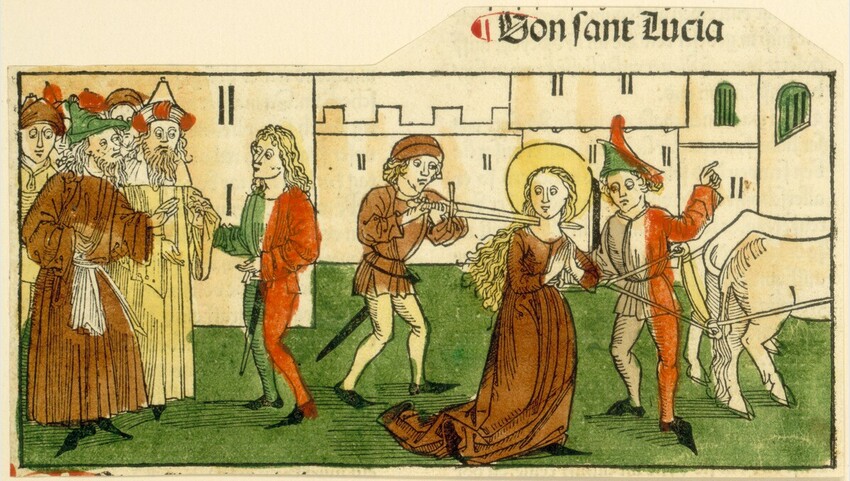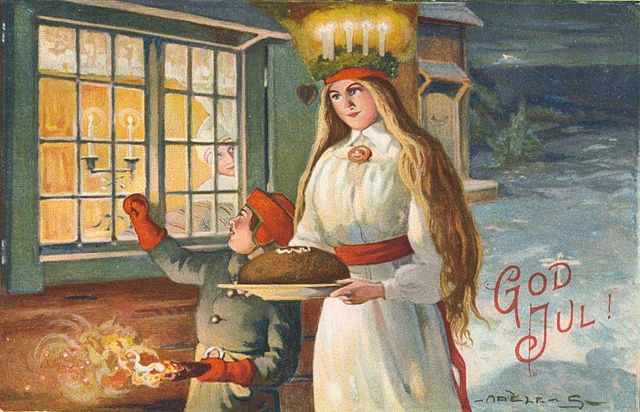St Lucy’s Feast (or Luciadagen) on the 13th of December is a great way to bring cheer to the cold, dark days before the Winter solstice. Let’s look at a little bit of history and traditions for some inspiration.

This day occurs in the liturgical season of Advent (the four weeks leading up to Christmas). Unbeknownst to the mainstream culture today, traditional Advent is actually a season of fasting and penance. Falling right in the middle of Advent was St Lucy’s Feast. This was an important feast in Catholic Europe, and especially in mediaeval Scandinavia. And it is still a day of big celebration in Sweden.
Who Was St Lucy?
St Lucy was a Christian martyr from the time of the Diocletian persecution in 304 AD. She was from Syracuse, Sicily. Much of her story is shrouded in legend. But the basic story goes like this:
She was a young and beautiful girl who had been betrothed to a pagan suitor. However, she had secretly vowed to remain a virgin and give her entire love in serving Jesus Christ. With that, she gave all her dowry away to the poor. The slighted suitor angrily denounced her to the authorities to be a Christian. Legend says that her eyes were gouged out and they tried to burn her to death. However the fire kept miraculously dying out. Eventually she was martyred by the sword.

Another legend is that before her arrest, Lucy would secretly bring sustenance to Christians hiding in the Roman catacombs. She wore a wreath of candles for light on her head, leaving both hands free to carry baskets of food.
In Sweden, the tradition continues on. Girls dressed in white (representing Lucy’s purity)and a red sash (representing her martyrdom) and wearing wreaths of candles go around, sharing sweet breads and pastries.

Why Scandinavia?
The real St Lucy lived and died in Sicily. So why is she so popular amongst Scandinavians? Well, that can be a lengthy discussion. But here are a couple of main points to consider. For one, St Lucy isn’t the only early Roman saint to be lovingly “adopted” by Northern European Catholics. For example, St George and St Nicolas, historical contemporaries of St Lucy, were also beloved saints in the North. These were the first generation of saints, as it were, to be venerated by the Church around when the Germanic peoples were first accepting the Catholic Faith. These newly-converted Northerners sought out culturally relatable aspects from these early martyrs. But why St. Lucy?
It’s all about Light
The Latin name “Lucy” means light. In the far North, the concept of light has an important place in the culture. After all, the land goes from eternal Daylight to the land of eternal night over the course of a year. St Lucy’s Feast falls on the darkest time of the year. The waning daylight certainly has an effect on the human person. It can instill depression and even despair. Memory of the pagan past might start to creep back in.
Hence, the candles of St Lucy’s crown are a reminder of the virtue of Hope amidst a world of darkness and cold. And though these candles may be small in comparison to the surrounding gloom; they pierce through, burning brightly and confidently. They bring warmth and anticipation for the imminent coming of the Saviour at Christmas.
Food and Drink for St Lucy’s Feast
How appropriate it is then to adapt St Lucy’s Feast for your own home! Indeed, what better way to prepare for Christmas? Need some ideas? Here are some simple Swedish traditions from our home:
Glögg: This is the Scandinavian version of hot mulled wine. Read all about it here:
How to Make Mulled Wine–Both German and Scandinavian Traditions
Sweetbreads: Spices like ginger, cinnamon and cardamom are a trademark to holiday Scandinavian baking. For St Lucy’s Feast, Lussekatter (or Lucia buns) are a favorite. These are lightly sweet and fluffy, topped with two dried cherries (symbolizing St Lucy’s eyes), and pearl sugar.
Also popular are ginger bread and pepparkakor cookies along with almonds and raisins.
Firelight: Perhaps you are lucky enough to have a fireplace or stove in your house, (currently, we are not that lucky). Otherwise candles are also very nice! Firelight really helps to bring an atmosphere of coziness and welcome–especially after coming inside after dusk.

Having good food and good drink is, of course, an important aspect to any festivity. But knowing a little bit of the historical and cultural context, makes the refreshment taste even better, in my opinion!
~ Nathanael


Leave a Reply